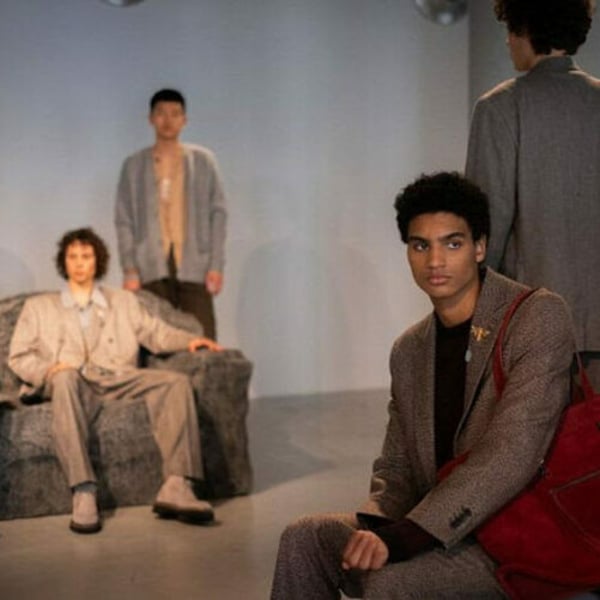Fashion
Portuguese footwear at London Fashion Week, presented by APICCAPS

Published
September 18, 2025
After showing at New York Fashion Week (NYFW), Portuguese footwear now takes to the catwalks of London Fashion Week (LFW) in partnership with the London College of Fashion (LCF), unveiling the first made in Portugal collection by Portuguese Footwear Award (PFA) winner Annie Purdy, to be presented at the Portuguese Embassy in London on September 18.
According to the press release sent by APICCAPS – the Portuguese Footwear, Components and Leather Goods Manufacturers’ Association, this collaboration with LCF, part of University of the Arts London (UAL), began in early 2025 with a masterclass on Portuguese footwear, as part of the Bioshoes4all project.
The Bioshoes4all project has enabled Portuguese footwear brands to team up with leading international designers to create exclusive collections which, since 2023, have been gracing the catwalks of New York, London and Paris for several seasons.
Aimed at master’s students, this awareness and knowledge-building session on the talent of Portuguese artisans and the industry landscape was led by Portuguese industry experts and award-winning designer Bianca Saunders, who has long been involved in Portuguese savoir-faire.
This was followed by the first edition of the PFA, designed to introduce future designers to production possibilities in Portugal, in which Annie Purdy won and went on to develop her first collection in Portugal, which has now been unveiled.
According to the young designer, a graduate of LCF-UAL: “The inspiration arose from the relationship between ‘craftsmanship’ and innovation, exploring how traditional skills can coexist with experimental and avant-garde design.”
“Access to in-depth knowledge of materials and high-quality manufacturing expertise allowed me to expand my concepts, knowing they could be realised with precision and durability,” she continued. “It gave me the freedom to experiment, without losing sight of feasibility and ‘craftsmanship’.”
“I learnt to consider a product’s longevity, function and life cycle from the outset,” she added in regards to her collaboration with APICCAPS. “From now on, I will continue to integrate these concerns into my practice, ensuring that my work always balances narrative, design integrity and sustainable responsibility.”
This article is an automatic translation.
Click here to read the original article.
Copyright © 2025 FashionNetwork.com All rights reserved.
Fashion
CFDA to implement fur ban at NYFW from September 2026
Fashion
ECB keeps interest rates unchanged, upgrades growth outlook

According to updated Eurosystem staff projections, headline inflation is expected to average 2.1 per cent in 2025, easing to 1.9 per cent in 2026 and 1.8 per cent in 2027, before returning to 2.0 per cent in 2028. Inflation excluding energy and food is forecast at 2.4 per cent in 2025, gradually declining to 2.0 per cent by 2028. Inflation for 2026 has been revised upward, mainly due to expectations that services inflation will fall more slowly than previously anticipated, the Governing Council of the ECB said in a press release.
European Central Bank has kept its key interest rates unchanged, maintaining confidence that inflation will stabilise at the 2 per cent target.
Updated projections show inflation easing gradually over the coming years, with a slight upward revision for 2026 due to persistent services prices.
Economic growth forecasts have been revised higher, supported by stronger domestic demand.
The ECB also revised its economic growth outlook higher compared with its September projections. Growth is now expected to reach 1.4 per cent in 2025, 1.2 per cent in 2026 and 1.4 per cent in 2027, with expansion projected to remain at 1.4 per cent in 2028. The improvement is driven largely by stronger domestic demand across the euro area.
The Council reiterated its commitment to ensuring that inflation stabilises sustainably at the 2 per cent target. It emphasised that future monetary policy decisions will remain data-dependent and assessed on a meeting-by-meeting basis, without pre-committing to any specific interest rate path.
Fibre2Fashion News Desk (KD)
Fashion
US brand Vera Bradley posts net revenue of $62.3 million in Q3

Vera Bradley reported Q3 net revenues of $62.3 million, down from $70.5 million year over year.
Direct revenues fell 5.3 per cent, with comparable sales down 5.8 per cent, while indirect revenues dropped 30.2 per cent.
Gross margin declined to 42.1 per cent, impacted by inventory write-downs and higher duties, despite early progress from its Project Sunshine transformation.
Source link
-

 Business6 days ago
Business6 days agoHitting The ‘High Notes’ In Ties: Nepal Set To Lift Ban On Indian Bills Above ₹100
-

 Politics1 week ago
Politics1 week agoTrump launches gold card programme for expedited visas with a $1m price tag
-

 Business1 week ago
Business1 week agoRivian turns to AI, autonomy to woo investors as EV sales stall
-

 Fashion1 week ago
Fashion1 week agoTommy Hilfiger appoints Sergio Pérez as global menswear ambassador
-

 Sports1 week ago
Sports1 week agoPolice detain Michigan head football coach Sherrone Moore after firing, salacious details emerge: report
-

 Business1 week ago
Business1 week agoCoca-Cola taps COO Henrique Braun to replace James Quincey as CEO in 2026
-

 Tech1 week ago
Tech1 week agoGoogle DeepMind partners with UK government to deliver AI | Computer Weekly
-

 Sports1 week ago
Sports1 week agoU.S. House passes bill to combat stadium drones



















